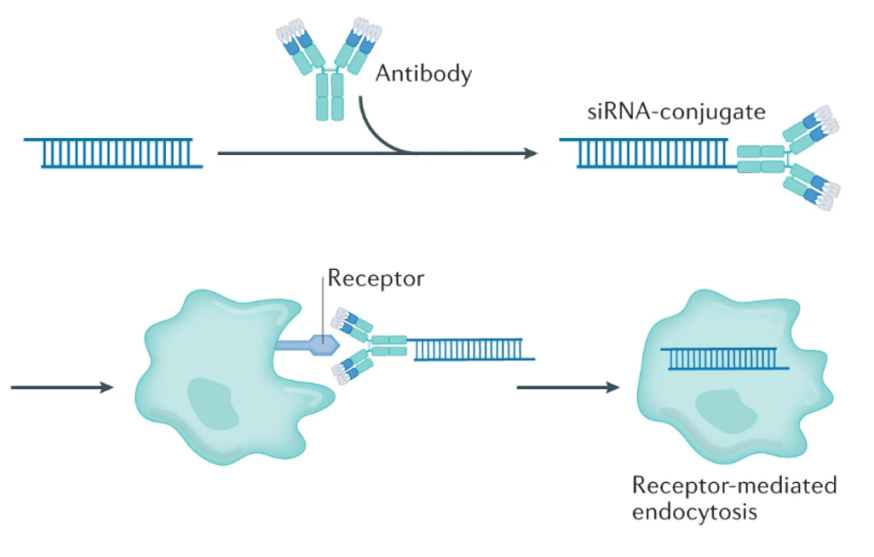Antibody-siRNA Conjugation (ARC)
As a leading CRO, BOC Sciences is dedicated to providing custom conjugation services to clients at the forefront of drug conjugation. The development of siRNAs has received a lot of interest from researchers as a result of FDA-approved siRNAs, and the design of siRNA delivery systems is a key challenge for further clinical applications. Therefore, antibody siRNA conjugates have emerged as potential carriers for targeted siRNA delivery. BOC Sciences is able to provide antibody siRNA conjugation services to meet your unique project needs. Our scientific team will work with you to create a scope of work to complete the project on time and within specifications.
Find out more with Drug Conjugation Services.
What is siRNA?
Small interfering RNA (siRNA) is a kind of macromolecular drugs with a molecular weight of approximately 13 kDa belonging to a family of small non-encoding ribonucleic acid (sncRNA). siRNAs, as double-stranded RNAs, suppress protein translation by recruiting RNA-induced silencing complex (RISC) to mRNA via Watson-Crick base pairing. siRNAs can target and silence aimed gene expression such as oncogenes, tumor suppressor genes and other regulatory genes by specific sequence recognition with mRNA. Despite advances siRNA-based therapies, low delivery efficiency and limited bio-barriers penetrability (owing to its strong negative charge and hydrophilic property) appear to be major obstacles for targeted siRNA therapeutics.
What are Antibody siRNA Conjugates?
Antibody-siRNA conjugate (ARC), an emerging siRNA drug delivery strategy, can overcome the current barriers in siRNA delivery. Inspired by the concept of ADC , ARC consists of the ligand (antibody) and the warhead (siRNA). ARCs can be produced by conjugating siRNA directly with multiple chemical groups in the antibody. Classical ARCs are prepared mainly based on the natural lysine residues in natural antibody or the cysteine residues reduced from the interchain disulfide bonds. Common conjugation methods involved in ARCs include Sulfhydryl and maleimide reaction, Amino and β-lactam ring-opening reaction, Biotin and avidin affinity reaction, etc. In addition, the antibody and siRNA also can be combined through electrostatic interactions, which has not been as widely used as chemical conjugation methods.
 Fig 1. Antibody directly conjugated to siRNA (Paunovska, 2022)
Fig 1. Antibody directly conjugated to siRNA (Paunovska, 2022)
Our Services for Antibody siRNA Conjugates
- Custom siRNA design
- Custom siRNA synthesis
- High throughput siRNA screening
- Site-specific chemically modified siRNA
- Conjugation methods and linkers optimization
- Antibody siRNA conjugates
- siRNA delivery
Ralated siRNA Conjugation
- GalNAc-siRNA
- Cholesterol conjugated siRNA
- Fluorescent labeled siRNA
- Liposome siRNA
Examples of antibody-siRNA conjugates:
| Linker | Antibody/Fragment type | siRNA | Application |
| Sulfhydryl-maleimide | Anti-CD71 Fab fragment | ApoB, HPRT, myostatin siRNA | Muscle diseases therapy |
| THIOMAB | siGenome HPS4-3, OTP HPS4-8 siRNA | Delivery system | |
| Amino + β-lactam ring | Humanized DVD-IgG | Human β-catenin (CTNNB1) siRNA | Delivery system |
| Avidin-biotin | Heavy chain variable region (VH) of 2C10 | tNASP siRNA | Anti-mammal cancer |
| Polyclonal IgG-targeting antibody | Nephrin siRNA, TRPC6 siRNA | Podocytes-injured glomerular diseases treatment | |
| Anti-human insulin receptor antibody | Anti-luciferase siRNA | Anti-cancer siRNA delivery system | |
| Poly-lysine | RGD peptide | Anti-luciferase siRNA | Anti-tumor siRNA delivery |
Applications of Antibody siRNA Conjugates
Antibody-mediated siRNA delivery systems can be a promising choice. For example, siRNAs have been delivered to extrahepatic tissues using ARCs. These conjugates with low immunity can achieve pretty therapeutic effects and their simple prepare process make them closer to clinical transform.
siRNA has great application prospects in treatments of varies diseases. siRNAs can be conjugated with antibodies for treating cancer such as breast cancer, prostate cancer, colon cancer, or other diseases such as HIV and leukemia.
Our Advantages
- Different ARC structures and batch development experience
- Various conjugation methods through chemical modification or noncovalent interactions
- A wide range of characteristic analysis
- People and suites that specialize in ARC development, manufacturing, and testing
- Data analysis, detailed report with results and discussion
- Cost-effective and high-quality products
Frequently Asked Questions (FAQ)
Antibody-siRNA conjugation (ARC) is a process that involves attaching small interfering RNA (siRNA) molecules to antibodies. This conjugation enables targeted delivery of siRNA to specific cells or tissues. The antibody recognizes a particular target molecule, while the siRNA can inhibit gene expression, allowing for precise control over gene silencing in molecular studies.
Antibody-siRNA conjugates are synthesized using various conjugation methods, including thiol-maleimide coupling, amine-reactive linkers, and click chemistry. These techniques allow for stable and efficient attachment of siRNA to the antibody, ensuring that both components retain their bioactivity and targeting capabilities.


References
- Cao, W., et al., Antibody-siRNA conjugates (ARC): Emerging siRNA drug formulation, Medicine in Drug Discovery, 2022, 15, 100128.
- Paunovska, K., Loughrey, D., and Dahlman, J. E., Drug delivery systems for RNA therapeutics, Nat. Rev. Genet., 2022, 23, 265-280.